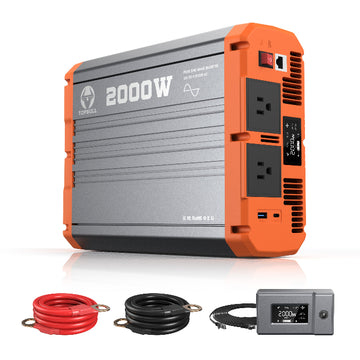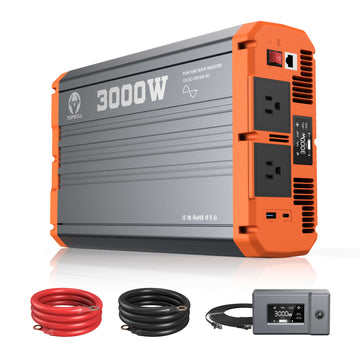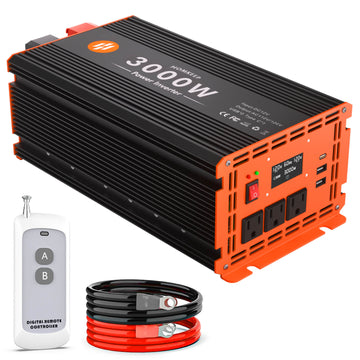In the wave of clean energy revolution, the U.S., as one of the world's largest economies, is actively promoting the large-scale development of the solar industry. As the core component of the PV system, the performance of solar inverters directly affects power generation efficiency and grid stability. According to Wood Mackenzie forecast, the U.S. PV inverter market size will exceed $16 billion in 2025, accounting for more than 30% of the global market. In this article, we will deeply analyze the market performance and advantageous products of the world's top ten inverter manufacturers.
Global Top 10 Inverter Manufacturers Overview
| Ranking | Manufacturer | States | Core Strengths | U.S. Market Share |
| 1 |
Enphase Energy |
U.S. | Microinverter leader, integrated solutions for energy storage | 45% |
| 2 | SolarEdge | Israel | Optimizer+inverter combination, high reliability | 28% |
| 3 |
|
China | Large-scale power plant solutions, high cost-effective | 12% |
| 4 | Huawei | China | AI fusion technology, complex power grid adaptation | 10% |
| 5 | SMA | Germany | Strength in household market, long-life design | 8% |
| 6 | Solis | China | String efficiency benchmark, 99.3% efficiency | 6% |
| 7 | Goodwe | China | Household energy storage linkage, BIPV solution | 5% |
| 8 | TMEIC | Japan | Centralized inverter, high-voltage adaption | 4% |
| 9 | Fimer | Switzerland | Three level technology, low harmonic distortion | 3% |
| 10 | Shangneng Electric | China | 1500V solution, cost optimized | 2% |
U.S. Solar Inverter Market Overview
Market Size and Growth
Shipments and space: The global inverter market size is expected to reach 66.3 billion yuan (about 9.7 billion U.S. dollars) in 2025, of which the U.S. market accounts for more than 30%, corresponding to a market space of about 16.3 billion yuan (2.4 billion U.S. dollars). String inverters accounted for 79% (about 12.8 billion yuan), centralized inverters accounted for 21% (about 3.5 billion yuan).
Growth driver: The Inflation Reduction Act provides more than $100 billion in funding support, and is expected to add 25GW (utility-scale) + 8GW (distributed) of new installations in 2025, an increase of 18% from 2024.
Competitive Landscape
Local companies: Enphase (microinverter leader), SolarEdge (optimizer + inverter solution), SMA (strong in household market) occupy household and industrial/commercial scenes.
Chinese companies: Huawei, Sungrow, Solis accounted for more than 45% of the large ground power plant and distributed market, facing tariffs and policy pressure (double reverse tax rate of 25%-78%).
In-depth analysis of the U.S. market for the world's top 10 inverter manufacturers
Enphase Energy (Microinverter Leader, U.S. Domestic King)
Company Profile:
Founded in 2006, Enphase Energy is a Silicon Valley technology enterprise and the pioneer of microinverter technology in the world. 2023, Enphase Energy was selected as one of the Fortune Future 50 companies, and its market value was among Hurun's top 500 companies in the world. 2024, Enphase Energy initiated a reorganization plan, closed down part of its business in Mexico, and laid off 500 employees, so as to focus on the U.S. domestic market strategically.
Advantageous products:
- IQ8 series microinverters: support for “grid-free operation”, integrated energy storage, adapted to complex grid environments.
- Enphase Energy System: Whole-house energy solution, compatible with electric vehicles and home energy storage, expected to ship 150-170MWh in 2025.
Market Performance:
- U.S. market share 45%, Q4 2024 revenue up 6% YoY, net income up 95.61% YoY.
Gross margin 41.3% (highest in the industry), expected 2025 revenue of $340-380 million.
- Policy response: plans to move battery manufacturing out of China and use IRA subsidies to avoid tariffs.
SolarEdge (optimizer pioneer, dual-driven in Europe and the US)
Company Description:
Israeli tech giant, pioneered power optimizer technology in 2006, laying off 900 (16% of employees) in 2024, closing Mexican plant to optimize costs. Core markets are Europe and the U.S., 62% of European revenue in 2023.
Advantageous products:
- Single-phase integrated energy storage system: modular design, supports 4kWh expansion to 22kWh, US domestic production by end of 2025.
- HD-Wave inverter: 99% efficiency, supports large residential HVAC systems, won 2025 Intersolar Innovation Award.
Market performance:
- U.S. market share 28%, total revenue down 13.32% in 2023 due to European inventory crisis, but U.S. revenue up 29% against the trend.
- Policy layout: planning for US factory to enjoy IRA subsidy, BlackRock Group increased its position to 15.8% stake.
Sungrow (China inverter giant, overseas breakout)
Company Profile:
China's clean energy leader, business covers 170 countries, with overseas bases in India/Thailand, etc. 2023 revenue of 72.25 billion yuan (+79.47%), overseas gross margin of 41.57% (twice as much as domestic).
Advantageous products:
- SG320HX string inverter: adapted to 1500V system, 99.1% efficiency, certified by California CEC.
- Large-scale ground power station solution: providing one-stop service of “inverter+tracking bracket+energy storage”, winning the bid for the US utility project.
Market performance:
- U.S. revenue accounts for 47.6% of overseas business ($12.175 billion by 2023), replacing Huawei as the top inverter company in the U.S.
- Avoiding tariffs: re-exporting through Brazilian/Chilean subsidiaries, Mexican factory covering North American market.
Huawei (AI convergence expert, policy breakout)
Company Description:
Global ICT leader, founded in 1987, digital energy business covering 60 countries. 2023 R&D investment of $164.7bn (23.4% of revenue), holds 140,000 patents.
Advantageous products:
- SUN2000-196KTL Smart Inverter: AI predicts power generation, adapts to weak grids, certified by Texas ERCOT.
- FusionSolar energy storage system: supports peak and valley tariff arbitrage, compatible with third-party batteries.
Market Performance:
- U.S. market share 10%, 1.2GW shipments in 2023 (affected by 301 tariffs).
- Policy response: joint local EPC to build California factory, apply for “Buy America” exemption.
SMA (German Seiko, household benchmark)
Company Profile:
Founded in Germany in 1981, household inverter benchmark, revenue down 18% in 2023 due to European market drag.
Advantageous products:
- Sunny Boy 8.0: household single-phase inverter, 98% efficiency, supports module-level monitoring.
- SMA Fuel Save Solution: hybrid inverter, suitable for diesel generator retrofit scenarios.
Market Performance:
- U.S. market share of 8%, 2025 plans to launch “household + energy storage” package.
- Policy layout: applying for IRA subsidy, cooperating with First Solar on recycling program.
Solis (string efficiency king, cost killer)
Company Profile:
China string inverter expert, global top 5 in terms of shipment in 2023, significant growth in US market.
Advantageous products:
- Solis-50K-EH string inverter: 99.3% efficiency, support 1500V system, UL certified.
Commercial and industrial energy storage solutions: compatible with BYD batteries, cycle life over 6000 times.
Market Performance:
- U.S. market share 6%, Q4 2024 shipments up 42% YoY.
- Cost advantage: China production + Mexico transit, avoiding 30% tariff.
Goodwe (Household storage pioneer, BIPV expert)
Company Profile:
Founded in Suzhou in 2010, high-tech enterprise, selected as one of China's top 500 energy companies in 2024 (318th). Core technology covers power electronics, new energy control, energy storage conversion and other fields, product service 100+ countries.
Advantageous products:
- GT-FH series hybrid inverters: support off-grid operation, adapted to areas without electricity.
- BIPV PV Roof: competes with Tesla Solar Roof, certified by Florida Building Code.
Market Performance:
- 5% market share in the U.S., 200MW expected to be shipped in 2025.
- Partners: long-term supply agreements with Sunrun and SunPower.
TMEIC (Japanese concentration, high voltage king)
Company Profile:
JV between Toshiba and Mitsubishi in 2003, focusing on industrial-grade inverters, with a plant in Texas, USA, in 2024, and an annual capacity of over 500 units.
Advantageous products:
- TM-PV9000 series: support 1500V/3.3MW, certified by Hawaii HECO.
- Energy storage converter: response speed <20ms, FERC FM compliant.
Market Performance:
- U.S. market share 4%, participating in 400MW power plant project in Nevada.
- Policy Challenge: Dependent on Japanese supply chain, facing IRA localization requirements.
Fimer (Swiss Seiko, three-level king)
Company Profile:
Founded in Italy in 1942, acquired ABB's inverter business in 2020, fourth largest supplier in the world.
Advantageous products:
- PVS-100TL three-level inverter: 98.5% efficiency, suitable for tracking bracket.
- Energy storage integration solution: cooperation with LG Chem, cycle efficiency 92%.
Market performance:
- U.S. market share of 3%, participation in the California “virtual power plant” pilot in 2025.
- Technology Recognition: NREL Laboratory Efficiency Certification.
Shangneng Electric (China's cost-effective, power plant experts)
Company Profile:
China's leading centralized inverter, shipping over 10GW in 2023.
Advantageous products:
- SUN2000-185KTL: 1500V solution, cost 12% lower than 1000V.
- Liquid-cooled energy storage system: supports 4-hour continuous discharge, certified by Arizona APS.
Market Performance:
- 2% market share in the US, focusing on utility projects.
Policy response: joint venture with local developers to avoid tariffs.
Summary
In the wave of global energy transformation, the solar inverter market is staging a symphony of technology iteration and strategic games. From the innovation of Silicon Valley to the rise of manufacturing in the East, from the intelligent breakthrough of household systems to the efficiency revolution of large-scale power plants, the competition trajectory of the top ten manufacturers has profoundly revealed the industry code: technology is the king, compliance is the foundation, and localized layout has become the key to victory.
In the face of the green barriers constructed by the IRA Act, Chinese enterprises are breaking through with supply chain resilience, European and American players are accelerating technological iteration to guard their home turf, and Japanese forces are reshaping their competitiveness with hybrid strategies. This energy revolution across three continents will eventually make solar inverters evolve from the “heart of power generation” to the “hub of energy intelligence”, and write an industrial epic belonging to the clean energy era in the journey of carbon neutrality.











![How to Install A Power Inverter in A Truck [Best Guide]](http://www.topbullshop.com/cdn/shop/articles/How-to-Install-A-Power-Inverter-in-A-Truck.jpg?v=1743407247&width=360)

